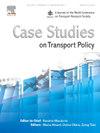Assessing truck driver fatigue perceptions: Insights from a South African road freight context
IF 3.3
Q3 TRANSPORTATION
引用次数: 0
Abstract
Background
Truck driver fatigue, influenced by health and operational conditions, compromises safety performance. Passenger and freight transport share the road, and any lapse in performance is detrimental. Ensuring that truck drivers are healthy to perform their work responsibilities is critical. This study evaluates driver perceptions of health, safety, and fatigue by developing and validating ten fatigue-related constructs, including company support, driver wellness, work pressures, driver engagement, health awareness, and home environment.
Objective
The study assessed fatigue-related perceptions among truck drivers in a South African road freight carrier to identify areas for improvement.
Method
A survey of 1788 professional truck drivers was conducted to develop and evaluate these constructs using exploratory and confirmatory factor analysis. Cohen’s d was applied to compare business units within the carrier, highlighting significant differences and identifying best practices.
Results
Drivers reported high ratings in company support (x̄ = 3,806), safety culture (x̄ = 3,655), driver engagement (x̄ = 4,221), and a supportive home environment (x̄ = 3,554). However, a gap exists between perceived support and health awareness (x̄ = 2,681) and status (x̄ = 2,620), indicating a need for targeted health interventions to enhance fatigue-related knowledge and behaviour. Significant differences between business units (BUs) suggest the need for tailored interventions, learning from top performers (such as BU3 in West Africa and BU5 in hazardous goods transport), and addressing issues in underperforming units, such as BU1 in time-sensitive transport.
Conclusion
Effective fatigue management requires collaboration with truck drivers and external organisations (customers, truck stops, government) to tackle health and awareness challenges, tailoring solutions to the specific needs of each operation.
Contribution
Insights into driver perceptions can guide policy decisions to improve health and safety by enhancing knowledge, healthy behavioural choices, and access to supportive resources.
评估卡车司机疲劳感知:来自南非公路货运背景的见解
卡车司机的疲劳受健康和操作条件的影响,会影响安全性能。客运和货运共用一条道路,任何疏忽都是有害的。确保卡车司机健康地履行其工作职责至关重要。本研究通过开发和验证十个与疲劳相关的概念,包括公司支持、司机健康、工作压力、司机参与、健康意识和家庭环境,来评估司机对健康、安全和疲劳的看法。目的:本研究评估了南非公路货运公司卡车司机的疲劳相关认知,以确定需要改进的领域。方法采用探索性因子分析和验证性因子分析方法,对1788名专业货车司机进行问卷调查。Cohen’s d被用于比较运营商内部的业务部门,突出了显著的差异,并确定了最佳实践。结果司机在公司支持(x ā = 3,806)、安全文化(x ā = 3,655)、司机参与度(x ā = 4,221)和支持性家庭环境(x ā = 3,554)方面的评分很高。然而,感知到的支持和健康意识(x′= 2 681)与现状(x′= 2 620)之间存在差距,这表明需要有针对性的健康干预措施,以加强与疲劳有关的知识和行为。业务单位(BUs)之间的显著差异表明,需要采取量身定制的干预措施,向表现最好的单位(如西非的BU3和危险品运输的BU5)学习,并解决表现不佳的单位(如时间敏感型运输的BU1)的问题。结论:有效的疲劳管理需要与卡车司机和外部组织(客户、卡车停靠站、政府)合作,以应对健康和意识方面的挑战,并根据每个操作的具体需求定制解决方案。对驾驶员观念的洞察可以指导政策决策,通过增进知识、健康的行为选择和获得支持性资源来改善健康和安全。
本文章由计算机程序翻译,如有差异,请以英文原文为准。
求助全文
约1分钟内获得全文
求助全文

 求助内容:
求助内容: 应助结果提醒方式:
应助结果提醒方式:


